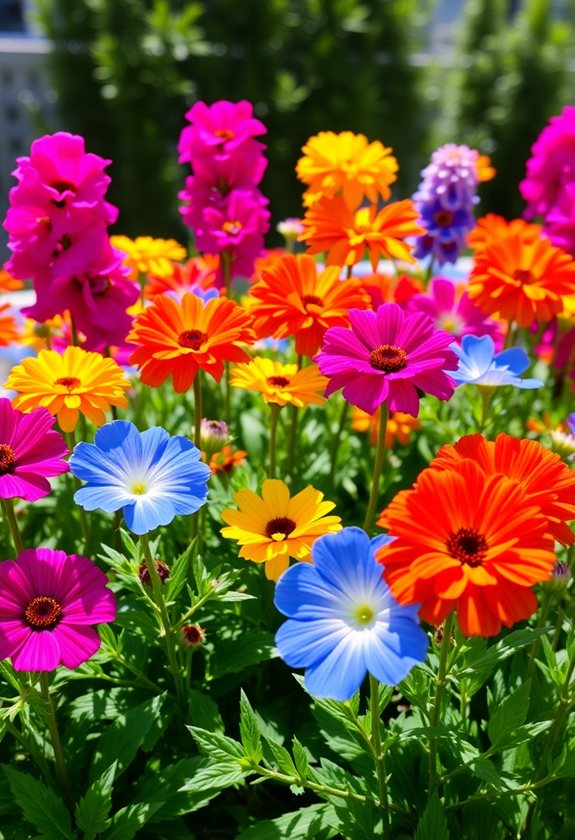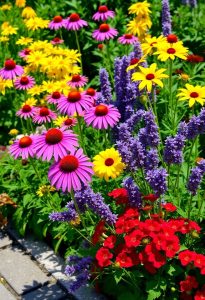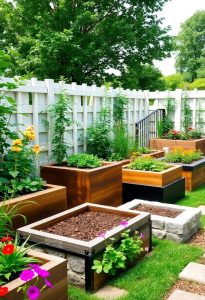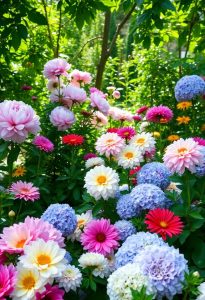If you want a bold color flower bed that makes your garden pop, start by choosing vibrant flowers like sunflowers or zinnias! Mix shapes and sizes for excitement, and pair complementary colors for that wow factor. Don’t forget to plant in layers—tall ones in the back! Give them some TLC with deep watering and deadheading. Curious about seasonal planting tips or how to pick the right flowers? Stick around for more on creating your floral masterpiece!
Design Highlights
- Select flowers with vibrant hues and experiment with unexpected color pairings for a striking visual impact.
- Use complementary colors for bold contrast and triadic colors for a balanced, colorful display.
- Arrange flowers in layers, placing taller varieties at the back and shorter ones in the front for depth.
- Mix shapes and sizes to create visual interest and enhance the overall color scheme of your flower bed.
- Incorporate species that attract pollinators to add liveliness and vibrancy to your garden.
Choosing the Right Flowers for Bold Colors
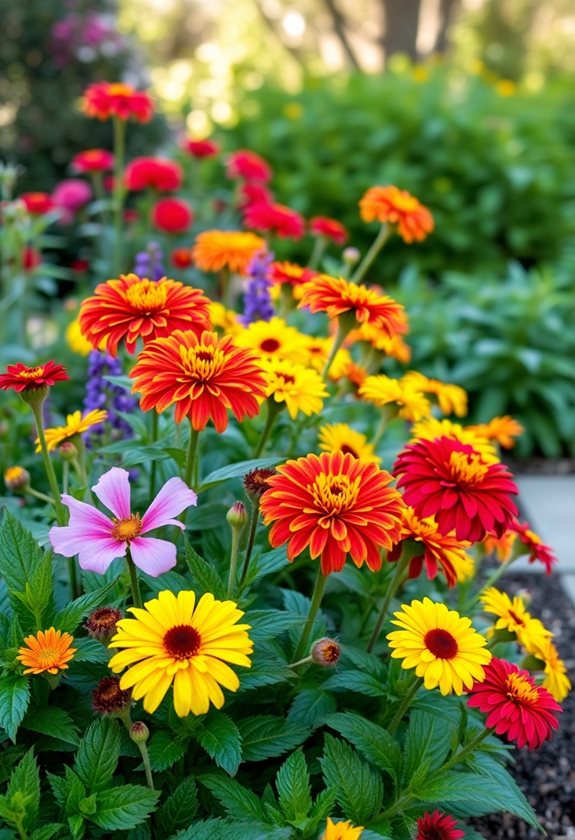
When you’re immersing yourself in the world of bold color flower beds, choosing the right flowers can feel a bit overwhelming—especially when you want to create a stunning display that turns heads! Start by selecting flowers that boast vibrant hues like sunflowers, zinnias, or dahlias. Consider mixing shapes and sizes for added interest. Remember, the right flowers should bloom at different times to keep your garden lively throughout the season. Don’t shy away from experimenting—try pairing unexpected colors! Have you ever thought about how a fiery red can make a sunny yellow pop? To maximize the impact of your flower bed, think about planting species that are known to attract pollinators and enhance the vibrancy of your garden. Immerse yourself, and let your creativity bloom!
Understanding Color Combinations and Harmonies
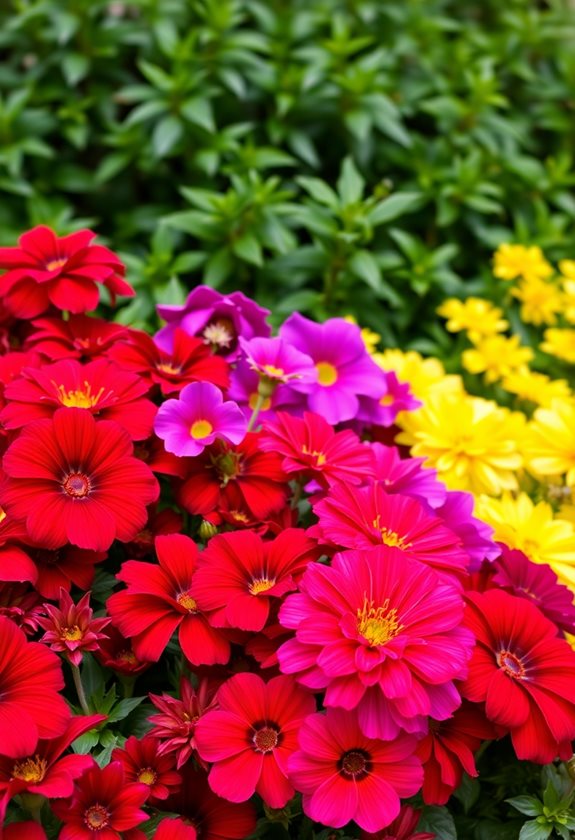
Creating a flower bed that catches the eye isn’t just about picking vibrant blooms; it’s also about how those colors work together. Understanding color combinations and harmonies can transform your garden into a masterpiece! Here are some key principles to keep in mind:
Transform your garden into a masterpiece by understanding how colors harmonize in your flower bed.
- Complementary Colors: Pair colors opposite each other on the color wheel for a striking contrast.
- Analogous Colors: Use colors next to each other for a harmonious, serene effect.
- Triadic Colors: Choose three colors evenly spaced on the wheel for a balanced, colorful display.
Experimenting with these combinations can lead to stunning results! Choosing the best flowers can greatly enhance the overall color scheme of your garden. What’s your favorite color duo?
Planning the Layout of Your Flower Bed
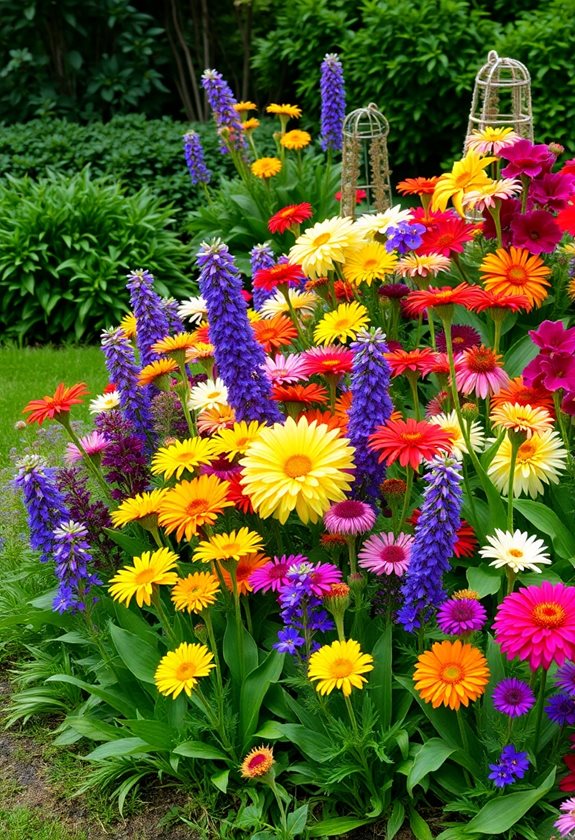
Before you immerse yourself in planting, it’s essential to plan the layout of your flower bed carefully; after all, a well-thought-out design can make your vibrant blooms pop even more! Start by choosing a focal point—maybe a tall sunflower or a bold dahlia. Arrange your flowers in layers, placing taller plants in the back and shorter ones in the front. Don’t forget to take into account color contrasts! Use a mix of shapes and sizes for visual interest, too. And hey, why not sketch your design first? It’s like creating a masterpiece before the painting begins! Additionally, consider incorporating best flowering plants that thrive in your local climate for optimal growth. Happy gardening!
Ensuring Proper Care and Maintenance
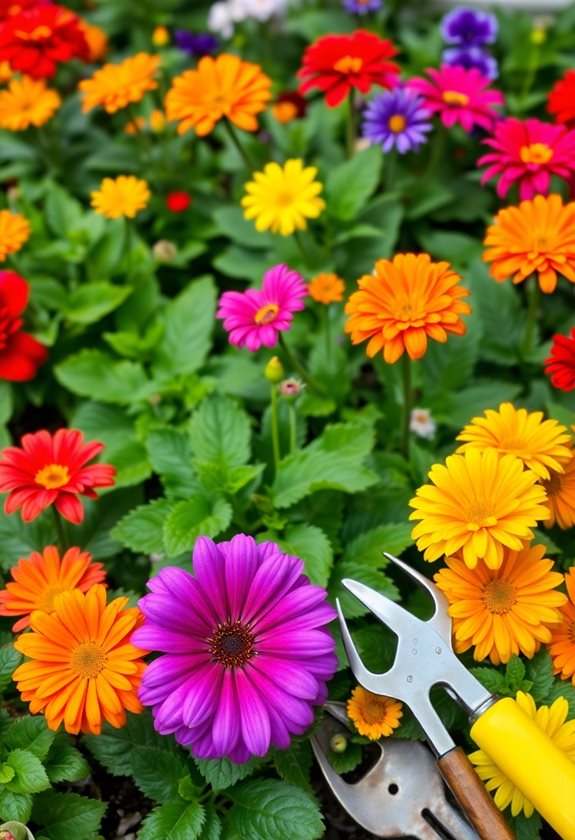
Now that you’ve sketched out an eye-catching layout for your flower bed, it’s time to think about how to keep those vibrant blooms thriving all season long. Regular care is key! Here are three essential tips:
Time to nurture your flower bed! Regular care ensures vibrant blooms all season long.
- Water Wisely: Make sure your flowers get enough moisture, but avoid overwatering. A good rule of thumb is to water deeply once a week.
- Deadhead Often: Snipping off spent blooms encourages new growth and keeps your garden looking fresh.
- Fertilize Smartly: Use a balanced fertilizer to provide nutrients, but don’t go overboard; it can burn your plants. Additionally, choosing low-maintenance plants can significantly reduce the amount of care needed.
Happy gardening! Your blooms will thank you!
Timing Your Planting for Seasonal Impact
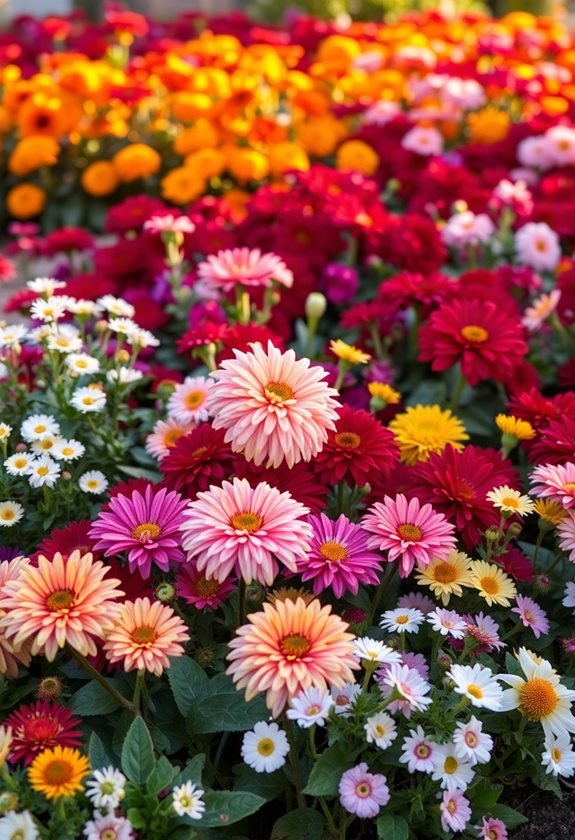
When you think about planting your flower bed, timing can make all the difference in how your garden flourishes. Imagine witnessing a burst of color as each season unfolds! Start by considering your local climate—spring blooms like tulips thrive in early planting, while summer favorites like zinnias need warmth.
Here’s a quick guide:
- Spring: Plant cool-season flowers.
- Summer: Introduce heat-loving varieties.
- Fall: Think about perennials for a vibrant comeback.
Don’t forget to check frost dates! Trust me, planting at the right moment is like giving your garden a standing ovation. Additionally, incorporating perennial flowers can ensure continuous blooms and vibrant color throughout the year. So, are you ready to dig in?
Frequently Asked Questions
What Types of Soil Are Best for Bold Color Flower Beds?
When you’re planning vibrant flower beds, the right soil is key! You’ll want a well-draining, nutrient-rich mix. Consider using a loamy soil that retains moisture but doesn’t get soggy. Adding organic matter, like compost, can supercharge your garden, providing essential nutrients. Don’t forget to test your soil’s pH—most flowers love a slightly acidic to neutral range. Have you ever faced a garden flop? Good soil can turn that around!
How Can I Attract Pollinators to My Flower Bed?
So, you wanna turn your flower bed into a bustling bee café? Well, you’ve come to the right place! To attract pollinators, plant native flowers like coneflowers and milkweed—they’re like the five-star dining spots for bees and butterflies! Don’t forget to avoid pesticides; they’re the party poopers of the garden. Also, consider adding a shallow water source; who doesn’t love a revitalizing drink? Your garden will buzz with life in no time!
What Are Some Common Pests That Affect Bold Flowers?
Common pests can wreak havoc on your bold flower beds! You might encounter aphids, which suck sap, or slugs that munch leaves. Have you noticed holes in your petals? That could be from caterpillars! Don’t forget about spider mites—they love a warm, dry environment. To tackle these pests, try introducing beneficial insects like ladybugs or using neem oil as a natural remedy. Gardening’s a journey, but with a little effort, you’ll keep your blooms thriving!
Should I Use Annuals or Perennials for Bold Color?
So, you’re wondering if annuals or perennials are better for bold color? It’s like choosing between a thrilling summer blockbuster or a classic that keeps giving! Annuals burst with vibrant colors and last one season, perfect for instant impact. Perennials, on the other hand, return year after year, creating lasting beauty. Why not mix both? You get the excitement of annuals and the reliability of perennials! What a colorful combo, right?
How Do I Create a Focal Point in My Flower Bed?
Creating a focal point in your flower bed can transform your garden! Start by choosing a standout plant or structure—maybe a vibrant, tall flower or a beautiful birdbath. Position it centrally or slightly off-center for visual interest. Surround it with complementary blooms to enhance its appeal. Don’t forget to contemplate height, color, and texture. Have fun experimenting! After all, your garden should reflect your personality, right? What will your focal point be?

